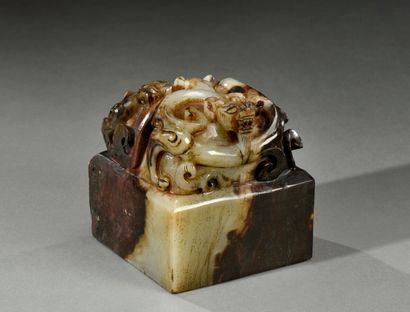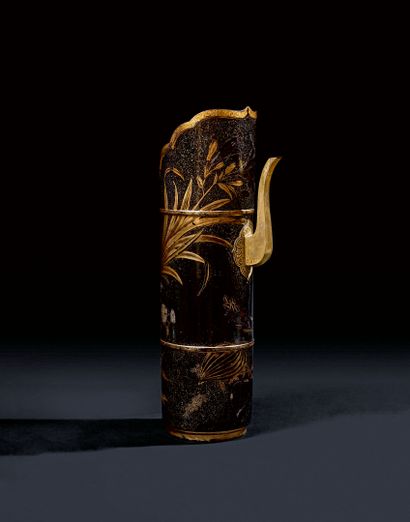Importante gourde en porcelaine A Décor de la famille rose d'influence Européenne comprenant des rinceaux d'inspiration de la mouvance Rococco (Caractéristique apparu dans les décors Chinois suite à la présence de missionnaires européens à la cour, le plus connu étant l’italien Giuseppe Castiglione contenant deux cartouches refermant un décor famille-rose de paysages et de la scène de "Haiwu Tianshou", l'ensemble sur fond vert-pomme rehaussé de scraffiato (de l'italien graffiare : griffer) On notera l'ajout de peinture de couleur or au col et sur le talon qui confèrent un aspect noble et impérial à l’objet. La forme de gourde fut utilisée depuis de 15e siècle et dérive de forme de gourdes de pèlerin portables venant de l’Asie centrale et Asie de l’ouest (favorisée par les mandchoues de la dynastie Qing, originaires de l’ouest et ayant pris le contrôle de la chine au 17e siècle) Les anses à forme de ruyi sur le présent objet étaient à l'origine utilisées pour attacher les gourdes à la ceinture des cavaliers durant les voyages Cet objet fragile était fabriqué dans un but d’appréciation esthétique et de démonstration de prouesse technique plus que pour une utilisation quotidienne Finalement notons la présence d'une marque Qianlong à six caractères sous la base : 'Da Qing Qianlong Nian Zhi', ultime signe d'une provenance impériale de l’objet du fait que ces marques furent apposée uniquement sur des pièces destinée au Palais Provenance: Colonel Yves Onno, gouverneur militaire de la base de Tien Tsin dans les années 1930. Hauteur : 18 cm CHINA, XVIIIth century. Qianlong mark and period. Double Ribbon Gourd Vase Decorated with Foreign Enamel Landscape Painting in a Cartouche on a Floral Brocade Background. This double ribbon gourd vase (1), decorated with a rococo-inspired floral pattern against a brocade background in apple green glaze and fine landscape painting in a gold bordered cartouche, is an excellent example of the enamel wares produced during the Qianlong reign (1736–1795). The shape of the double ribbon gourd vase, often called “hulu shoudai pin” in Chinese, is derived from established forms that had already appeared during the Hongwu reign (1368–1398) and were often used for blue-and-white vessels during the next two reigns of the early Ming dynasty. This form, in turn, was inspired by the shape of portable liquor containers from Central and Western Asia. It is no surprise that the Manchu ruling house of the Qing dynasty was in favor of the Altaic cultural flavor of the shape as this form, though integrated into the inventory of Chinese blue-and-white, still gestures towards the multiethnic aesthetics of the empire. The ribbon was used to facilitate hanging when warrior owners were mounted on horseback. Yet the ribbon fashioned in the auspicious fungus (ruyi) shape on this piece shows the typically playful and flamboyant court style of the Qianlong reign. Refined and delicate as it is, this piece was obviously made for aesthetic appreciation and technical pride rather than utilitarian purposes. Tied to two large exotic lotuses (Chinese: xifan lian) at the center of the neck and close to the foot, the curly floral patterns executed with a heavy chiaroscuro meander across the surface of the entire vessel. The dramatic shading on the floral scrolls and the calculated white highlights touch on pearls scattered among floral leaves to showcase the well-known European influence on Chinese painting and decorative surfaces during the Qianlong reign. The Imperial Archive and memorial records document how European missionaries and their court disciples were involved in painting porcelain in the court workshops (Chinese: Zaoban chu). Even the coral red applied to the interior of the golden cartouche attempts to enhance the three-dimensionality of the border. Another feature of the extravagant color palette deployed in the mid eighteenth century is the refreshing apple green background with a scrolling leaf pattern incised by needles
Importante gourde en porcelaine A Décor de la famille rose d'influence Européenne comprenant des rinceaux d'inspiration de la mouvance Rococco (Caractéristique apparu dans les décors Chinois suite à la présence de missionnaires européens à la cour, le plus connu étant l’italien Giuseppe Castiglione contenant deux cartouches refermant un décor famille-rose de paysages et de la scène de "Haiwu Tianshou", l'ensemble sur fond vert-pomme rehaussé de scraffiato (de l'italien graffiare : griffer) On notera l'ajout de peinture de couleur or au col et sur le talon qui confèrent un aspect noble et impérial à l’objet. La forme de gourde fut utilisée depuis de 15e siècle et dérive de forme de gourdes de pèlerin portables venant de l’Asie centrale et Asie de l’ouest (favorisée par les mandchoues de la dynastie Qing, originaires de l’ouest et ayant pris le contrôle de la chine au 17e siècle) Les anses à forme de ruyi sur le présent objet étaient à l'origine utilisées pour attacher les gourdes à la ceinture des cavaliers durant les voyages Cet objet fragile était fabriqué dans un but d’appréciation esthétique et de démonstration de prouesse technique plus que pour une utilisation quotidienne Finalement notons la présence d'une marque Qianlong à six caractères sous la base : 'Da Qing Qianlong Nian Zhi', ultime signe d'une provenance impériale de l’objet du fait que ces marques furent apposée uniquement sur des pièces destinée au Palais Provenance: Colonel Yves Onno, gouverneur militaire de la base de Tien Tsin dans les années 1930. Hauteur : 18 cm CHINA, XVIIIth century. Qianlong mark and period. Double Ribbon Gourd Vase Decorated with Foreign Enamel Landscape Painting in a Cartouche on a Floral Brocade Background. This double ribbon gourd vase (1), decorated with a rococo-inspired floral pattern against a brocade background in apple green glaze and fine landscape painting in a gold bordered cartouche, is an excellent example of the enamel wares produced during the Qianlong reign (1736–1795). The shape of the double ribbon gourd vase, often called “hulu shoudai pin” in Chinese, is derived from established forms that had already appeared during the Hongwu reign (1368–1398) and were often used for blue-and-white vessels during the next two reigns of the early Ming dynasty. This form, in turn, was inspired by the shape of portable liquor containers from Central and Western Asia. It is no surprise that the Manchu ruling house of the Qing dynasty was in favor of the Altaic cultural flavor of the shape as this form, though integrated into the inventory of Chinese blue-and-white, still gestures towards the multiethnic aesthetics of the empire. The ribbon was used to facilitate hanging when warrior owners were mounted on horseback. Yet the ribbon fashioned in the auspicious fungus (ruyi) shape on this piece shows the typically playful and flamboyant court style of the Qianlong reign. Refined and delicate as it is, this piece was obviously made for aesthetic appreciation and technical pride rather than utilitarian purposes. Tied to two large exotic lotuses (Chinese: xifan lian) at the center of the neck and close to the foot, the curly floral patterns executed with a heavy chiaroscuro meander across the surface of the entire vessel. The dramatic shading on the floral scrolls and the calculated white highlights touch on pearls scattered among floral leaves to showcase the well-known European influence on Chinese painting and decorative surfaces during the Qianlong reign. The Imperial Archive and memorial records document how European missionaries and their court disciples were involved in painting porcelain in the court workshops (Chinese: Zaoban chu). Even the coral red applied to the interior of the golden cartouche attempts to enhance the three-dimensionality of the border. Another feature of the extravagant color palette deployed in the mid eighteenth century is the refreshing apple green background with a scrolling leaf pattern incised by needles















Try LotSearch and its premium features for 7 days - without any costs!
Be notified automatically about new items in upcoming auctions.
Create an alert